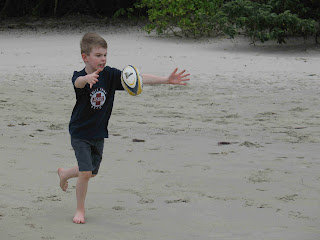After the short crossing we made our way to the Daintree Discovery Centre, an incredible (and award-winning) eco-tourism centre that allows you to safely explore and experience the rainforest floor and canopy through walkways, boardwalks and a 5 story tower. Here is William as we are beginning our tour. He is wearing one of the audio sets that explains everything we are looking at along the walk.
The Daintree Rainforest encompasses approximately 1200 sq. km. It is the largest block of tropical rainforest in Australia and is one of the most complex eco-systems on earth. From a total of 19 primitive flowering plant families on earth, 12 of them are found in the Daintree. It contains over 30% of Australia's frogs, marsupial and reptile species, 65% of Australia's bat and butterfly species and 20% of its bird species. The Kuku Yalangi people occupied this land for many thousands of years. (Daintree Discovery Centre Interpretive Guide).
Although this centre is a refuge/haven for such a large number of species (animals, birds, butterflies, reptiles) we didn't actually see much that day other than the trees. We could hear birds all around us but they were very difficult to sight. I did see one butterfly, but it wasn't the "Ulysses Blue", which the area is so well known for.

There are over 150 species of trees in the Daintree Rainforest. Note the twisted "vines" that grow around and up the trunk of another tree - very interesting!
After the Rainforest Dicsovery Centre and a yummy packed lunch, we continued north to Cape Tribulation, the point where explorer Captain James Cook (who achieved the first European contact with the eastern coastline of Australia) struck coral reef in 1770, writing in his diary "here began all our troubles...". Keep in mind that the further north we travel, the narrower and slower the travelling gets. (In fact, the road to Cape Tribulation has only been "sealed" in the last few years.) Despite this, there are many tourist accommodations along the way and quite a bit of tourist traffic on the road.
Walking from our car to the beach at Cape Tribulation, we came across this mangrove bog. The picture doesn't do it justice, but it reminded us of some of the creepy settings in "Lord of the Rings"

Thankfully July is not stinger season. To the left you can see the top of a bottle just inside the metal tube. This is a bottle of vinegar, which is used to treat stinger "stings".
...Looking south....

It was a very cloudy and windy day....
...but that's not enough to stop a good go at footy (yet again!)...

Funnily enough, we bumped into our friends Alan and Julie and their kids Calum and Abigail. (They had left Trinity Beach earlier than we had so had managed to travel further north than us, where they saw a cassowary along the side of the road - an amazing find!. Cassowary's are large birds that are related to emus. They have a very distinctive blue neck and a hard "beak" of sorts on the top of their heads.) We had a quick visit on the beach then headed off for ice cream! Later that evening, when we had returned to Trinity Beach, we all went out for supper together at a local restaurant. The food and company were great!








No comments:
Post a Comment